Pricing Guides & Dictionary of Makers Marks for Antiques & Collectibles

A few examples of appraisal values for
CORNERSTONE
Search our price guide for your own treasures
-
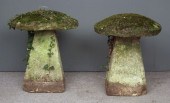 A pair of sandstone staddle
A pair of sandstone staddle stones with slightly domed tops and tapered square bases each 24ins diameter x 30ins high (both covered in lichen - one chipped in two places and the other chipped in one place and with bases chipped)
A pair of sandstone staddle
A pair of sandstone staddle stones with slightly domed tops and tapered square bases each 24ins diameter x 30ins high (both covered in lichen - one chipped in two places and the other chipped in one place and with bases chipped) -
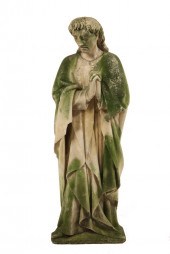 SANDSTONE SCULPTURE - Large
SANDSTONE SCULPTURE - Large Sandstone Sculpture of a Standing Saint hands clasped in prayer on integral base with bolt attachments at back 43'' tall 14'' x 8'' with greening and weathering from outdoor installation very heavy.
SANDSTONE SCULPTURE - Large
SANDSTONE SCULPTURE - Large Sandstone Sculpture of a Standing Saint hands clasped in prayer on integral base with bolt attachments at back 43'' tall 14'' x 8'' with greening and weathering from outdoor installation very heavy. -
 CAST STONE AMORINI ON STAND The
CAST STONE AMORINI ON STAND The little deity standing clutching bunches of grapes atop a wreath-decorated base h:61 w:16 d:16 in. Other Notes: DHS
CAST STONE AMORINI ON STAND The
CAST STONE AMORINI ON STAND The little deity standing clutching bunches of grapes atop a wreath-decorated base h:61 w:16 d:16 in. Other Notes: DHS -
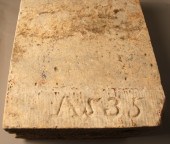 U.S. CAPITOL LATROBE
U.S. CAPITOL LATROBE ARCHITECTURAL SANDSTONE BLOCK FROM STEPS OF ORIGINAL EAST WING PORTICO large piece of Aquia Creek sandstone a numbered and lettered remnant of the East Wing Portico steps of the Nation's Capitol of 1828 designed by Benjamin Latrobe and adapted and installed under Bulfinch's tenure marked ''AS35'' h:8.75 w:19 d:12.50 in.
U.S. CAPITOL LATROBE
U.S. CAPITOL LATROBE ARCHITECTURAL SANDSTONE BLOCK FROM STEPS OF ORIGINAL EAST WING PORTICO large piece of Aquia Creek sandstone a numbered and lettered remnant of the East Wing Portico steps of the Nation's Capitol of 1828 designed by Benjamin Latrobe and adapted and installed under Bulfinch's tenure marked ''AS35'' h:8.75 w:19 d:12.50 in. -
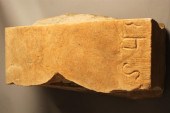 U.S. CAPITOL LATROBE
U.S. CAPITOL LATROBE ARCHITECTURAL SANDSTONE BLOCK FROM STEPS OF ORIGINAL EAST WING PORTICO large piece of Aquia Creek sandstone a numbered and lettered remnant of the East Wing Portico steps of the Nation's Capitol of 1828 designed by Benjamin Latrobe and adapted and installed under Bulfinch's tenure marked ''S41'' h:8.50 w:18.50 d:11 in.
U.S. CAPITOL LATROBE
U.S. CAPITOL LATROBE ARCHITECTURAL SANDSTONE BLOCK FROM STEPS OF ORIGINAL EAST WING PORTICO large piece of Aquia Creek sandstone a numbered and lettered remnant of the East Wing Portico steps of the Nation's Capitol of 1828 designed by Benjamin Latrobe and adapted and installed under Bulfinch's tenure marked ''S41'' h:8.50 w:18.50 d:11 in. -
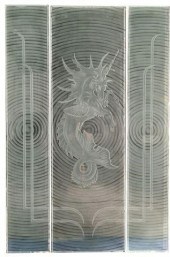 (3) CORNERSTONE GLASSWORKS
(3) CORNERSTONE GLASSWORKS HIPPOCAMP WINDOWS(lot of 3) Architectural carved and etched glass hippocamp windows, Cornerstone Glassworks, McKinney, Texas, late 20th c., comprising: (2) approx 81"h, 13.5"w, (1) approx 81"h, 21.75"w
(3) CORNERSTONE GLASSWORKS
(3) CORNERSTONE GLASSWORKS HIPPOCAMP WINDOWS(lot of 3) Architectural carved and etched glass hippocamp windows, Cornerstone Glassworks, McKinney, Texas, late 20th c., comprising: (2) approx 81"h, 13.5"w, (1) approx 81"h, 21.75"w -
 A Scholar's Rock the stone of a
A Scholar's Rock the stone of a metallic black with white veining raised on a fitted hardwood base. Height of stone 4 1/4 inches.
A Scholar's Rock the stone of a
A Scholar's Rock the stone of a metallic black with white veining raised on a fitted hardwood base. Height of stone 4 1/4 inches. -
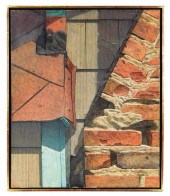 JOHN MCCLUSKY (AMERICAN, 1914 -
JOHN MCCLUSKY (AMERICAN, 1914 - 1994), "FOUNDATION CORNER", OIL ON MASONITE, DEPICTS A CLOSE-UP OF EXTERIOR WALL OF MIXED COMPONENTS...John McClusky (American, 1914 - 1994), "Foundation Corner", oil on masonite, depicts a close-up of exterior wall of mixed components including brick, tin, shingles and wood, dotted with spider-webs, signed LL, some scattered loss throughout, framed, titled verso, not examined out of frame, small damages to frame, canvas size: 24" h. x 20" w. [Deaccessioned from a New England Institution]
JOHN MCCLUSKY (AMERICAN, 1914 -
JOHN MCCLUSKY (AMERICAN, 1914 - 1994), "FOUNDATION CORNER", OIL ON MASONITE, DEPICTS A CLOSE-UP OF EXTERIOR WALL OF MIXED COMPONENTS...John McClusky (American, 1914 - 1994), "Foundation Corner", oil on masonite, depicts a close-up of exterior wall of mixed components including brick, tin, shingles and wood, dotted with spider-webs, signed LL, some scattered loss throughout, framed, titled verso, not examined out of frame, small damages to frame, canvas size: 24" h. x 20" w. [Deaccessioned from a New England Institution] -
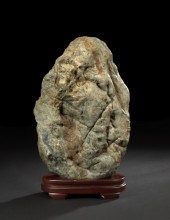 Chinese Scholar's Gazing
Chinese Scholar's Gazing Stone-on-Stand, composed of a green and ochre naturally weathered stone in the form of a weathered mountainous peak on a custom-fitted wooden stand, h. 24-1/4".
Chinese Scholar's Gazing
Chinese Scholar's Gazing Stone-on-Stand, composed of a green and ochre naturally weathered stone in the form of a weathered mountainous peak on a custom-fitted wooden stand, h. 24-1/4". -
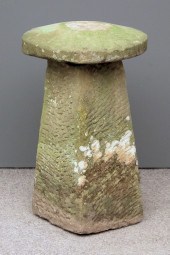 A 19th Century sandstone staddle
A 19th Century sandstone staddle stone 18ins diameter x 29ins high (slight damage and weathered)
A 19th Century sandstone staddle
A 19th Century sandstone staddle stone 18ins diameter x 29ins high (slight damage and weathered) -
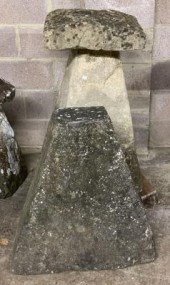 A large stone staddle stone, 99cm
A large stone staddle stone, 99cm high, and the base for another
A large stone staddle stone, 99cm
A large stone staddle stone, 99cm high, and the base for another -
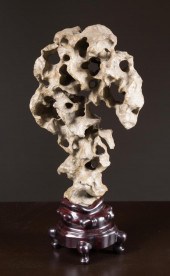 CHINESE SCHOLAR ROCK, A VERTICAL
CHINESE SCHOLAR ROCK, A VERTICAL STONE STRUCTURE RCHINESE SCHOLAR ROCK, a vertical stone structure raised on a conforming footed rosewood plinth. Height overall 16 inches.
CHINESE SCHOLAR ROCK, A VERTICAL
CHINESE SCHOLAR ROCK, A VERTICAL STONE STRUCTURE RCHINESE SCHOLAR ROCK, a vertical stone structure raised on a conforming footed rosewood plinth. Height overall 16 inches. -
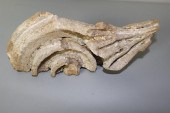 U.S. CAPITOL LATROBE
U.S. CAPITOL LATROBE ARCHITECTURAL SANDSTONE CORINTHIAN CAPITAL FRAGMENT FROM THE ORIGINAL EAST WING PORTICO Aquia Creek sandstone Corinthian capital fragment from the original columns of 1828 designed by Benjamin Latrobe and adapted and installed under Bulfinch's tenure with paint residue h:11 w:4.50 d:4 in.
U.S. CAPITOL LATROBE
U.S. CAPITOL LATROBE ARCHITECTURAL SANDSTONE CORINTHIAN CAPITAL FRAGMENT FROM THE ORIGINAL EAST WING PORTICO Aquia Creek sandstone Corinthian capital fragment from the original columns of 1828 designed by Benjamin Latrobe and adapted and installed under Bulfinch's tenure with paint residue h:11 w:4.50 d:4 in. -
 A stone obelisk modern on four ball
A stone obelisk modern on four ball feet and square plinth and a staddle stone base
A stone obelisk modern on four ball
A stone obelisk modern on four ball feet and square plinth and a staddle stone base -
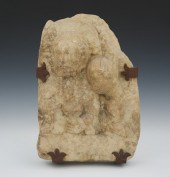 An Architectural Sculpture Fragment
An Architectural Sculpture Fragment Probably French Carved stone possibly limestone depicting Christ with hand in blessing gesture and with halo with additional figure the stone bound in iron straps so it may stand upright or hang on wall. 11-1/2"T x 8"W x 3"D.
An Architectural Sculpture Fragment
An Architectural Sculpture Fragment Probably French Carved stone possibly limestone depicting Christ with hand in blessing gesture and with halo with additional figure the stone bound in iron straps so it may stand upright or hang on wall. 11-1/2"T x 8"W x 3"D. -
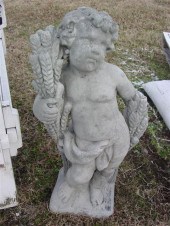 CAST STONE STATUE The miniature
CAST STONE STATUE The miniature deity clasping a sheaf of wheat to his side an allegory of fall h:37 in. Other Notes: DHS
CAST STONE STATUE The miniature
CAST STONE STATUE The miniature deity clasping a sheaf of wheat to his side an allegory of fall h:37 in. Other Notes: DHS -
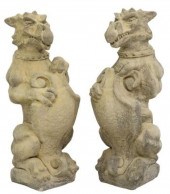 (2) CAST STONE GARDEN STATUARY,
(2) CAST STONE GARDEN STATUARY, PARAGON GRIFFINS(pair) Cast stone garden statuary, Paragon Griffins, late 20th c., each in a seated position, holding a shield, rising on rectangular base, approx 28"h, 9"w, 10"d **PLEASE NOTE: All of the cast stone and garden pieces in this auction have inherent flaws and evidence of outdoor use. Most are likely to have small chips, hairlines or imperfections. Please assume that they are not in perfect condition and bid accordingly. Per our terms, there will be no refunds based on condition.**
(2) CAST STONE GARDEN STATUARY,
(2) CAST STONE GARDEN STATUARY, PARAGON GRIFFINS(pair) Cast stone garden statuary, Paragon Griffins, late 20th c., each in a seated position, holding a shield, rising on rectangular base, approx 28"h, 9"w, 10"d **PLEASE NOTE: All of the cast stone and garden pieces in this auction have inherent flaws and evidence of outdoor use. Most are likely to have small chips, hairlines or imperfections. Please assume that they are not in perfect condition and bid accordingly. Per our terms, there will be no refunds based on condition.** -
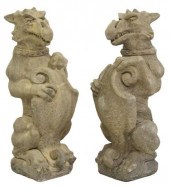 (2) CAST STONE GARDEN STATUARY,
(2) CAST STONE GARDEN STATUARY, PARAGON GRIFFINS(pair) Cast stone garden statuary, Paragon Griffins, late 20th c., each in a seated position, holding a shield, rising on rectangular base, approx 28"h, 9"w, 10"d **PLEASE NOTE: All of the cast stone and garden pieces in this auction have inherent flaws and evidence of outdoor use. Most are likely to have small chips, hairlines or imperfections. Please assume that they are not in perfect condition and bid accordingly. Per our terms, there will be no refunds based on condition.**
(2) CAST STONE GARDEN STATUARY,
(2) CAST STONE GARDEN STATUARY, PARAGON GRIFFINS(pair) Cast stone garden statuary, Paragon Griffins, late 20th c., each in a seated position, holding a shield, rising on rectangular base, approx 28"h, 9"w, 10"d **PLEASE NOTE: All of the cast stone and garden pieces in this auction have inherent flaws and evidence of outdoor use. Most are likely to have small chips, hairlines or imperfections. Please assume that they are not in perfect condition and bid accordingly. Per our terms, there will be no refunds based on condition.** -
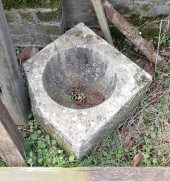 A STONE MORTAR probably 19th
A STONE MORTAR probably 19th Century, 25cm high x 40cm square (chipped to corner)
A STONE MORTAR probably 19th
A STONE MORTAR probably 19th Century, 25cm high x 40cm square (chipped to corner) -
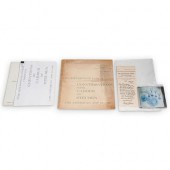 THE FIELDSTONE PORCH "CARDER ON
THE FIELDSTONE PORCH "CARDER ON STEUBEN" GROUPINGDESCRIPTION: A signed first limited edition "Conversations with Carder on Steuben. His American Glass" by The Fieldstone Porch. This grouping set includes: (2) Two 33 1/2" RPM Long Play "Conversations with Carder on Steuben", (1) One Cd "Conversations with Carder on Steuben", (1) one printed "Creations by Carder" interview transcription, (1) one colored "Creations by Carder" brochure catalogue, and one (1) ad newspaper cut. Provenance: Estate of Mr. and Ms. Alan Shovers. CIRCA: 1963. CONDITION: Vintage condition. Normal signs of age. See lot description for details on item condition. More detailed condition requests can be obtained via email (info@akibaantiques.com) or SMS 305-332-9274. Any condition statement given, as a courtesy to a client, is only an opinion and should not be treated as a statement of fact. Akiba Antiques shall have no responsibility for any error or omission.
THE FIELDSTONE PORCH "CARDER ON
THE FIELDSTONE PORCH "CARDER ON STEUBEN" GROUPINGDESCRIPTION: A signed first limited edition "Conversations with Carder on Steuben. His American Glass" by The Fieldstone Porch. This grouping set includes: (2) Two 33 1/2" RPM Long Play "Conversations with Carder on Steuben", (1) One Cd "Conversations with Carder on Steuben", (1) one printed "Creations by Carder" interview transcription, (1) one colored "Creations by Carder" brochure catalogue, and one (1) ad newspaper cut. Provenance: Estate of Mr. and Ms. Alan Shovers. CIRCA: 1963. CONDITION: Vintage condition. Normal signs of age. See lot description for details on item condition. More detailed condition requests can be obtained via email (info@akibaantiques.com) or SMS 305-332-9274. Any condition statement given, as a courtesy to a client, is only an opinion and should not be treated as a statement of fact. Akiba Antiques shall have no responsibility for any error or omission. -
 STONE FINIAL. American or European
STONE FINIAL. American or European early 20th century granite. Classical form with stylized egg and dart design. 25''h.
STONE FINIAL. American or European
STONE FINIAL. American or European early 20th century granite. Classical form with stylized egg and dart design. 25''h. -
 STONE YARD INC., VINOY PEDESTAL
STONE YARD INC., VINOY PEDESTAL Late 20th century, GFRC or Fiberstone material, one part form, square top with concave corners, in the style of stacked stones with a highly realistic finish and feel, appears unmarked but with original tear sheet.
STONE YARD INC., VINOY PEDESTAL
STONE YARD INC., VINOY PEDESTAL Late 20th century, GFRC or Fiberstone material, one part form, square top with concave corners, in the style of stacked stones with a highly realistic finish and feel, appears unmarked but with original tear sheet. -
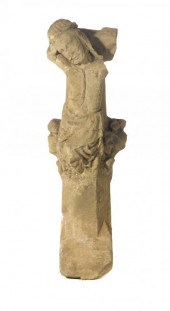 A GOTHIC LIMESTONE ARCHITECTURAL
A GOTHIC LIMESTONE ARCHITECTURAL FRAGMENT carved with the head and torso of the crucified Christ, before a tapered octagonal shaft with branching foliage, 79cm h, 14th/15th c
A GOTHIC LIMESTONE ARCHITECTURAL
A GOTHIC LIMESTONE ARCHITECTURAL FRAGMENT carved with the head and torso of the crucified Christ, before a tapered octagonal shaft with branching foliage, 79cm h, 14th/15th c -
 Chinese Sandstone Guardian Head
Chinese Sandstone Guardian Head on Base 15''x9''
Chinese Sandstone Guardian Head
Chinese Sandstone Guardian Head on Base 15''x9'' -
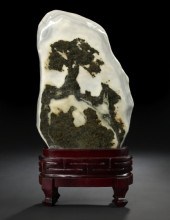 Chinese Two-Color Scholar's
Chinese Two-Color Scholar's Gazing Stone and Stand, the layered stone polished to reveal the dark brown figure of a Chinese oak tree on rockwork against a gray/white stone, presented on a carved wooden stand, h. 23".
Chinese Two-Color Scholar's
Chinese Two-Color Scholar's Gazing Stone and Stand, the layered stone polished to reveal the dark brown figure of a Chinese oak tree on rockwork against a gray/white stone, presented on a carved wooden stand, h. 23". -
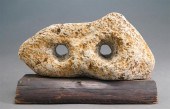 STONE CARVING ON WOOD BASEStone
STONE CARVING ON WOOD BASEStone Carving on Wood Base
STONE CARVING ON WOOD BASEStone
STONE CARVING ON WOOD BASEStone Carving on Wood Base -
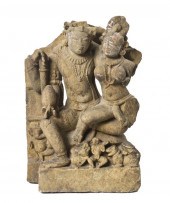 A Sandstone Stele Model of Shiva
A Sandstone Stele Model of Shiva and Parvati the embracing deities shown in a semi-seated pose adorned with strands of beads and necklaces raised atop lions with architectural carving visible at the side raised atop a rectangular base. Height 16 1/2 inches.
A Sandstone Stele Model of Shiva
A Sandstone Stele Model of Shiva and Parvati the embracing deities shown in a semi-seated pose adorned with strands of beads and necklaces raised atop lions with architectural carving visible at the side raised atop a rectangular base. Height 16 1/2 inches. -
 GROUP OF HARDSTONE SPECIMEN BIRDS
GROUP OF HARDSTONE SPECIMEN BIRDS AND FLOWERS Including seven examples of birds on quartz specimen bases and five hardstone models of flowers also on rockery bases (12)
GROUP OF HARDSTONE SPECIMEN BIRDS
GROUP OF HARDSTONE SPECIMEN BIRDS AND FLOWERS Including seven examples of birds on quartz specimen bases and five hardstone models of flowers also on rockery bases (12) -
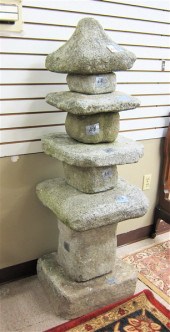 PRIMITIVE CHINESE GRANITE PAGODA
PRIMITIVE CHINESE GRANITE PAGODA TOWER comprising nine stacking stone segments.
PRIMITIVE CHINESE GRANITE PAGODA
PRIMITIVE CHINESE GRANITE PAGODA TOWER comprising nine stacking stone segments. -
 GROUP OF HARDSTONE SPECIMEN BIRDS
GROUP OF HARDSTONE SPECIMEN BIRDS AND FLOWERS Including seven examples of birds on quartz specimen bases and five hardstone models of flowers also on rockery bases (12)
GROUP OF HARDSTONE SPECIMEN BIRDS
GROUP OF HARDSTONE SPECIMEN BIRDS AND FLOWERS Including seven examples of birds on quartz specimen bases and five hardstone models of flowers also on rockery bases (12) -
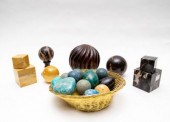 A collection of hardstone geometric
A collection of hardstone geometric balls and cubes and other stones
A collection of hardstone geometric
A collection of hardstone geometric balls and cubes and other stones -
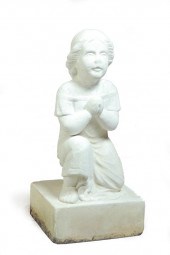 STONE STATUE. American or European
STONE STATUE. American or European 20th century. Weathered white marble of a young girl kneeling in prayer. Head repaired. 28''h. Condition reports are available on all items. Please note: unless a condition report is requested we do not post detailed condition information about each item sold. If you choose to bid without requesting a condition report you are accepting the item ''as-is'' with no gaurantees.
STONE STATUE. American or European
STONE STATUE. American or European 20th century. Weathered white marble of a young girl kneeling in prayer. Head repaired. 28''h. Condition reports are available on all items. Please note: unless a condition report is requested we do not post detailed condition information about each item sold. If you choose to bid without requesting a condition report you are accepting the item ''as-is'' with no gaurantees. -
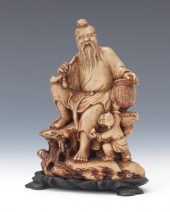 Carved Hardstone Seated Man with
Carved Hardstone Seated Man with Child Finely carved in gray hardstone with brown toning signed underneath depicting an old man with a basket seated on a rocky outcrop with a small child holding a ball at his feet.
Carved Hardstone Seated Man with
Carved Hardstone Seated Man with Child Finely carved in gray hardstone with brown toning signed underneath depicting an old man with a basket seated on a rocky outcrop with a small child holding a ball at his feet. -
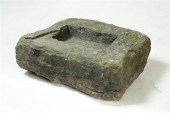 STONE TROUGH. American 19th
STONE TROUGH. American 19th century. Roughly hewn hardstone. 9''h. 22''w.
STONE TROUGH. American 19th
STONE TROUGH. American 19th century. Roughly hewn hardstone. 9''h. 22''w. -
 CAST STONE GARDEN PEDESTAL
CAST STONE GARDEN PEDESTAL CORINTHIAN COLUMN, 36"HCast stone garden pedestal, late 20th c., Corinthian capital, fluted column, on integral square base, approx 36"h, 10"w, 10"d **PLEASE NOTE: All of the cast stone and garden pieces in this auction have inherent flaws and evidence of outdoor use. Most are likely to have small chips, hairlines or imperfections. Please assume that they are not in perfect condition and bid accordingly. Per our terms, there will be no refunds based on condition.**
CAST STONE GARDEN PEDESTAL
CAST STONE GARDEN PEDESTAL CORINTHIAN COLUMN, 36"HCast stone garden pedestal, late 20th c., Corinthian capital, fluted column, on integral square base, approx 36"h, 10"w, 10"d **PLEASE NOTE: All of the cast stone and garden pieces in this auction have inherent flaws and evidence of outdoor use. Most are likely to have small chips, hairlines or imperfections. Please assume that they are not in perfect condition and bid accordingly. Per our terms, there will be no refunds based on condition.** -
 Cast stone garden statue, cast
Cast stone garden statue, cast stone or composition: statue with old weathered surface depicting Ceres, the goddess with draped attire and one arm raised, other arm holding cornucopia, 53 x 13 in., on conforming paneled pedestal, base 30-1/2 x 15-1/4 x 15-1/4 in., early 20th century. Figure with some separations and possible repairs at joints, old weathered surface with some wear, separate pedestal base with scattered wear and losses, some repairs especially at edges and corners, one corner off but present, both pieces with traces of early white paint.
Cast stone garden statue, cast
Cast stone garden statue, cast stone or composition: statue with old weathered surface depicting Ceres, the goddess with draped attire and one arm raised, other arm holding cornucopia, 53 x 13 in., on conforming paneled pedestal, base 30-1/2 x 15-1/4 x 15-1/4 in., early 20th century. Figure with some separations and possible repairs at joints, old weathered surface with some wear, separate pedestal base with scattered wear and losses, some repairs especially at edges and corners, one corner off but present, both pieces with traces of early white paint.
...many more examples with full details are available to our members - Learn more


